简介
本款实时时钟模块(RTC)采用DS3231芯片方案,芯片内部集成了晶体谐振器和温度补偿器,提高了模块的长期精度。在-40°C至+85°C范围内,DS3231的精度保持在±3.5ppm (±0.3024秒/天)。
DS3231可以用纽扣电池供电,断开主电源时仍可保持精确计时。RTC可提供秒、分、时、星期、日、月和年的信息,可以自动调整月末的日期、闰年修正。时钟格式可以是24小时或带AM/PM指示的12小时。提供两个可编程的日历闹钟和一个1Hz方波输出。另外,RST校验引脚可以作为微处理器复位的按键输入。
特性
- 内部集成晶体谐振器,误差小
- 内部集成温度补偿器,温度漂移小
- 完整的时钟日历功能
- 两个可编程日历闹钟
应用场景
- 事件提醒器
- MCU外部唤醒源
- 时钟、闹钟输出
技术规格
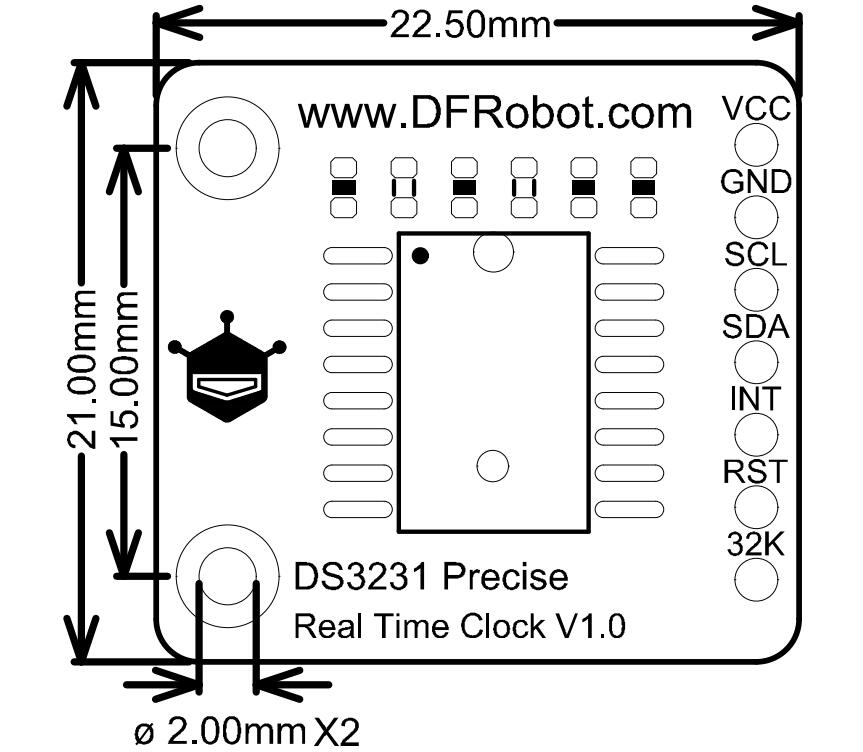
- 供电电压:3.3V-5.5V
- I2C地址:0x68
- 计时范围:1970 ~ 2100年
- 工作温度:-40℃ ~ +85℃
- 计时精度:±3.5ppm (±0.3024秒/天)
- 产品尺寸:22.5*21mm
引脚说明

| 序号 | 丝印 | 功能描述 |
|---|---|---|
| 1 | VCC | 电源正极 |
| 2 | GND | 电源负极 |
| 3 | SCL | I2C时钟线 |
| 4 | SDA | I2C数据线 |
| 5 | INT | 低电平有效中断或1Hz方波输出 |
| 6 | RST | 复位校验引脚 |
| 7 | 32K | 32.768KHz脉冲输出 |
注:INT引脚是sqw引脚
使用教程
准备
- 硬件
- 1 x Arduino UNO控制板
- 1 x DS3231高精度时钟模块
- 若干 杜邦线
- 软件
- Arduino IDE, 点击下载Arduino IDE
- DS323x库文件和示例程序
关于如何安装库文件,点击链接
- 主要API接口函数列表
/*!
*@brief 设置时间
*@param 年, 1900~2100
*@param 月, 1~12
*@param 日, 1~31
*@param 时: 0~23
*@param 分, 0~59
*@param 秒, 0~59
*/
void setTime(uint16_t year, uint8_t month, uint8_t date, uint8_t hour, uint8_t minute, uint8_t second);
/*!
*@brief 设置时制
*@param eHours_t mode:e24hours(24小时制), e12hours(12小时制). 默认24小时制
*/
void setHourSystem(eHours_t mode)
/*!
*@功能 获取年
*@返回 年
*/
uint16_t year();
/*!
*@功能 获取月
*@返回 月
*/
uint8_t month();
/*!
*@功能 获取日
*@返回 日
*/
uint8_t day();
/*!
*@功能 获取时
*@返回 时
*/
uint8_t hour();
/*!
*@功能 获取分
*@返回 分
*/
uint8_t minute();
/*!
*@功能 获取秒
*@返回 秒
*/
uint8_t second();
/*!
*@brief 获取星期几
*@return 星期几
*/
String getDayOfWeek();
typedef enum{
eEverySecond, //每秒触发
eSecondsMatch, //每分钟触发
eSecondsMinutesMatch, //每小时触发
eSecondsMinutesHoursMatch, //每天触发
eSecondsMinutesHoursDateMatch, //每月触发
eSecondsMinutesHoursDayMatch, //每周触发
}eAlarm1Types_t; //Alarm1
/*!
*@brief 设置闹钟1
*@param 闹钟工作模式
*@param 日 (1-31)
*@param 时 (0-23)
*@param 分 (0-59)
*@param 秒 (0-59)
*/
void setAlarm1(eAlarm1Types_t alarmType,int16_t days,int8_t hours,int8_t minutes,int8_t seconds);
typedef enum{
eEveryMinute, //每分钟触发
eMinutesMatch, //每小时触发
eMinutesHoursMatch, //每天触发
eMinutesHoursDateMatch, //每月触发
eMinutesHoursDayMatch, //每周触发
}eAlarm2Types_t; //Alarm2
/*!
*@brief 设置闹钟2
*@param 闹钟工作模式
*@param 日 (1-31)
*@param 时 (0-23)
*@param 分 (0-59)
*/
void setAlarm2(eAlarm2Types_t alarmType,int16_t days,int8_t hours,int8_t minutes);
/*!
*@brief 判断闹钟是否被触发
*@return eNoTrigger(没有触发),eAlarm1Trigger(闹钟1),eAlarm2Trigger(闹钟2),eAllTrigger(都触发)
*/
eTrigger_t isAlarmTrig();
接线图
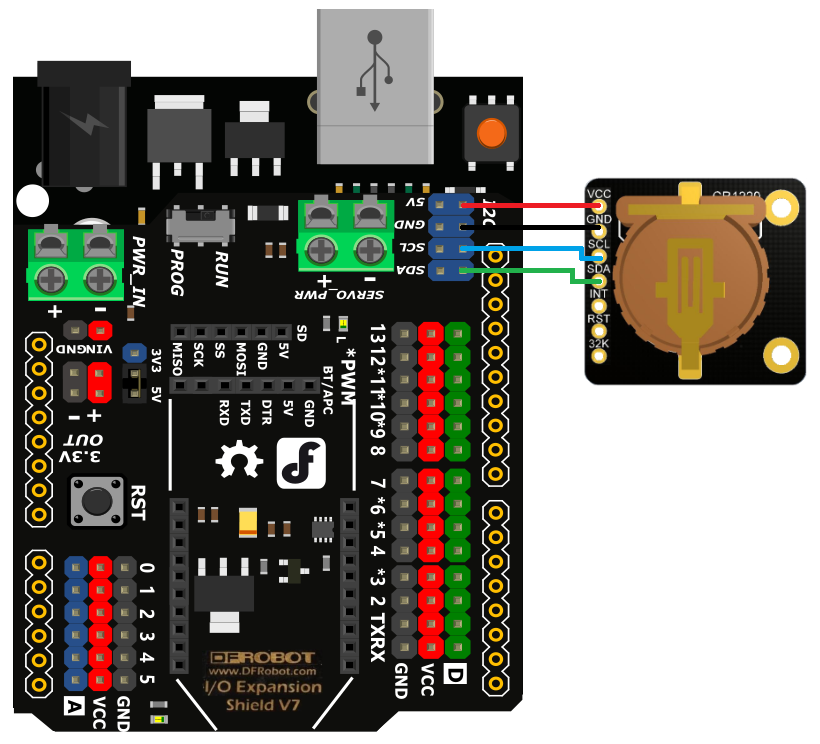
样例代码1 - 读取与设置时间
将时间设置为指定时间,串口每秒打印一次时间、温度数据
注意:内部温度传感器是用来补偿时钟的,精度不高,如果对温度准确度要求较高,请选择其他温度传感器
/*!
* @file getTimeAndTemperature.ino
* @brief Show current time and temperature of chip
* @n Experiment phenomenon: 由用户自行设置初始时间,并从芯片获取实时时间和温度
*
* @copyright Copyright (c) 2010 DFRobot Co.Ltd (http://www.dfrobot.com)
* @licence The MIT License (MIT)
* @author [LuoYufeng](yufeng.luo@dfrobot.com)
* @version V0.1
* @date 2021-2-23
* @url https://github.com/DFRobot/DFRobot_DS323X
*/
#include "DFRobot_DS323X.h"
DFRobot_DS323X rtc;
void setup(void)
{
Serial.begin(9600);
/*Wait for the chip to be initialized completely, and then exit*/
while(rtc.begin() != true){
Serial.println("Failed to init chip, please check if the chip connection is fine. ");
delay(1000);
}
/*!
*@brief 设置时间输出格式
*@param eHours_t:e24hours, e12hours. default is e24hours
*/
rtc.setHourSystem(rtc.e12hours);
rtc.setTime(/*year,1900-2100*/2021, /*mouth,1-12*/2, /*date,1-31*/28, /*hour,0-23*/23,/*minute,0-59*/59,/*second,0-59*/55);//Set Set initial time .
}
void loop() {
Serial.print(rtc.getYear(), DEC);//year
Serial.print('/');
Serial.print(rtc.getMonth(), DEC);//month
Serial.print('/');
Serial.print(rtc.getDate(), DEC);//date
Serial.print(" (");
Serial.print(rtc.getDayOfWeek());//day of week
Serial.print(") ");
Serial.print(rtc.getHour(), DEC);//hour
Serial.print(':');
Serial.print(rtc.getMinute(), DEC);//minute
Serial.print(':');
Serial.print(rtc.getSecond(), DEC);//second
Serial.print(' ');
/*if rtc works in 24hours mode,this function doesn't print anything*/
Serial.print(rtc.getAMorPM());
Serial.println();
Serial.print("Temperature: ");
/*!
*@brief Get current temperature
*@return Current temperautre, unit: ℃
*/
Serial.print(rtc.getTemperatureC());
Serial.println(" C");
delay(1000);
/*!
*@brief Judge if it is power-down
*@return If retrun true, power down, needs to reset time; false, work well.
*/
if (rtc.isLostPower()) {
Serial.println("RTC lost power, please reset the time!");
}
}
结果
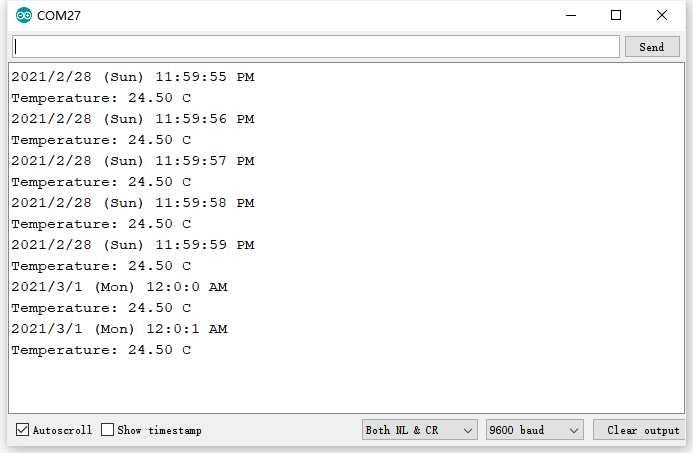
样例代码2 - 获取NTP时间
本样例是从NTP服务器上获取当前时间然后每秒打印
**注意:**本样例需要联网,所以需要ESP32系列主控板
如果没有编译环境,请配置ESP32编译环境
在配置好ESP32编译环境之后,需要选择FireBeetle-ESP32开发板和端口
/*!
* @file getTimefromNTP.ino
* @brief Get time from ntpServer and show current time ,only work on ESP32
*
* @copyright Copyright (c) 2010 DFRobot Co.Ltd (http://www.dfrobot.com)
* @licence The MIT License (MIT)
* @author [LuoYufeng](yufeng.luo@dfrobot.com)
* @version V0.1
* @date 2021-2-23
* @url https://github.com/DFRobot/DFRobot_DS323X
*/
#include "DFRobot_DS323X.h"
#include <WiFi.h>
#include "time.h"
DFRobot_DS323X rtc;
const char* ssid = "WIFI_ID";//wlan information
const char* password = "WIFI_PASSWORD";
const char* ntpServer = "ntp.ntsc.ac.cn";//local ntp server
const long gmtOffset_sec = 8*3600;
const int daylightOffset_sec = 0;
void getTimeFromNTP()
{
struct tm timeinfo;
if(!getLocalTime(&timeinfo)){
Serial.println("Failed to obtain time");
return;
}
rtc.setTime(timeinfo.tm_year + 1900, timeinfo.tm_mon + 1, timeinfo.tm_mday, timeinfo.tm_hour,timeinfo.tm_min,timeinfo.tm_sec);//Set Set initial time .
}
void setup()
{
Serial.begin(9600);
while(rtc.begin() != true){
Serial.println("Failed to init chip, please check if the chip connection is fine. ");
delay(1000);
}
//connect to WiFi
Serial.printf("Connecting to %s ", ssid);
WiFi.begin(ssid, password);
while (WiFi.status() != WL_CONNECTED) {
delay(500);
Serial.print(".");
}
Serial.println(" CONNECTED");
//init and get the time
configTime(gmtOffset_sec, daylightOffset_sec, ntpServer);
getTimeFromNTP();
//disconnect WiFi as it's no longer needed
WiFi.disconnect(true);
WiFi.mode(WIFI_OFF);
}
void loop()
{
Serial.print(rtc.getYear(), DEC);
Serial.print('/');
Serial.print(rtc.getMonth(), DEC);
Serial.print('/');
Serial.print(rtc.getDate(), DEC);
Serial.print(" (");
Serial.print(rtc.getDayOfWeek());
Serial.print(") ");
Serial.print(rtc.getHour(), DEC);
Serial.print(':');
Serial.print(rtc.getMinute(), DEC);
Serial.print(':');
Serial.print(rtc.getSecond(), DEC);
Serial.println(' ');
delay(1000);
}
结果
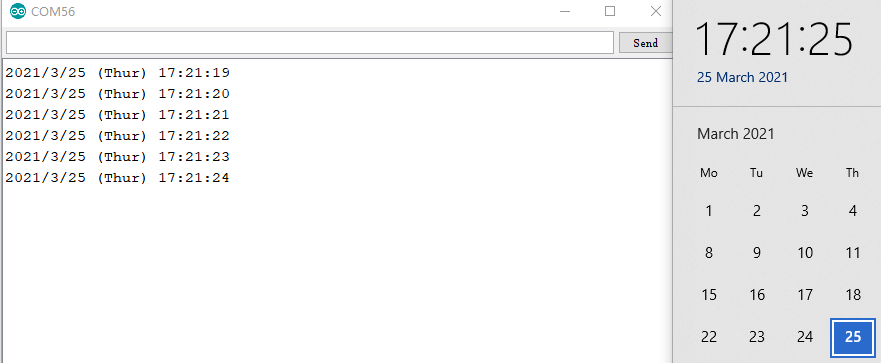
样例代码3 - 闹钟触发查询
本样例是通过loop函数里面rtc.isAlarmTrig();函数查询闹钟被触发。
/*!
* @file setAlarmInQuery.ino
* @brief Set alarm clock and trigger it in query
* @n Experiment phenomenon: set the alarm clock to trigger at a sepcified time
* @n Trigger when the set time of clock is the same with the RTC time
*
* @copyright Copyright (c) 2010 DFRobot Co.Ltd (http://www.dfrobot.com)
* @licence The MIT License (MIT)
* @author [LuoYufeng](yufeng.luo@dfrobot.com)
* @version V0.1
* @date 2021-2-23
* @url https://github.com/DFRobot/DFRobot_DS323X
*/
#include "DFRobot_DS323X.h"
DFRobot_DS323X rtc;
void setup(void)
{
Serial.begin(9600);
/*Wait for the chip to be initialized completely, and then exit*/
while(rtc.begin() != true){
Serial.println("failed to init chip, please check if the chip connection is fine");
delay(1000);
}
//rtc.setHourSystem();//Set time mode, default in the 24 hours mode, e24hours, eAM, ePM.
/*!
*@brief Set alarm clock
*@param alarmType Alarm clock working mode typedef enum{
*@n eEverySecond, //repeat in every second
*@n eSecondsMatch, //repeat in every minute
*@n eSecondsMinutesMatch, //repeat in every hour
*@n eSecondsMinutesHoursMatch, //repeat in every day
*@n eSecondsMinutesHoursDateMatch,//repeat in every month
*@n eSecondsMinutesHoursDayMatch, //repeat in every week //Alarm1
*@n eUnknownAlarm1
*@n }eAlarm1Types_t;
*@param days Alarm clock Day (day)
*@param hours Alarm clock Hour (hour)
*@param minutes Alarm clock Minute (minute)
*@param seconds Alarm clock Second (second)
*/
rtc.setAlarm1(rtc.eSecondsMatch,/*date,0-30*/1,/*hour,0-23*/0,/*minute,0-59*/0,/*second,0-59*/10);//Alarm1
/*!
*@brief Set alarm clock
*@param alarmType Alarm clock working mode typedef enum{
*@n eEveryMinute, //repeat in every minute
*@n eMinutesMatch, //repeat in every hour
*@n eMinutesHoursMatch, //repeat in every day
*@n eMinutesHoursDateMatch, //repeat in every month
*@n eMinutesHoursDayMatch, //repeat in every week //Alarm2
*@n eUnknownAlarm2
*@n }eAlarm2Types_t;
*@param days Alarm clock Day (day)
*@param hours Alarm clock Hour (hour)
*@param minutes Alarm clock Minute (minute)
*/
rtc.setAlarm2(rtc.eEveryMinute,/*date,0-30*/1,/*hour,0-23*/0,/*minute,0-59*/0);//Alarm2
if (rtc.isLostPower())
rtc.setTime(/*year,1901-2099*/2021, /*mouth,1-12*/2, /*date,1-31*/28, /*hour,0-23*/23,/*minute,0-59*/59,\
/*second,0-59*/55);//Set Set initial time .
}
void loop() {
/*!
*@brief Judge if the alarm clock is triggered
*@return eNoTrigger // No alarm is triggered
*@n eAlarm1Trigger // Alarm1 is triggered
*@n eAlarm2Trigger // Alarm2 is triggered
*@n eAllTrigger // All alarms are triggered
*/
if (rtc.isAlarmTrig() == rtc.eAlarm1Trigger){ // If the alarm bit is set
Serial.println("Alarm1 clock is triggered.");
/*!
*@brief Clear trigger flag
*/
rtc.clearAlarm();
}else if (rtc.isAlarmTrig() == rtc.eAlarm2Trigger){
Serial.println("Alarm2 clock is triggered.");
rtc.clearAlarm();
}else if (rtc.isAlarmTrig() == rtc.eAllTrigger){
Serial.println("Both Alarm clocks are triggered.");
rtc.clearAlarm();
}
Serial.print(rtc.getYear(), DEC);
Serial.print('/');
Serial.print(rtc.getMonth(), DEC);
Serial.print('/');
Serial.print(rtc.getDate(), DEC);
Serial.print(" (");
Serial.print(rtc.getDayOfWeek());
Serial.print(") ");
Serial.print(rtc.getHour(), DEC);
Serial.print(':');
Serial.print(rtc.getMinute(), DEC);
Serial.print(':');
Serial.print(rtc.getSecond(), DEC);
Serial.print(' ');
/*if rtc works in 24hours mode,this function doesn't print anything*/
Serial.print(rtc.getAMorPM());
Serial.println();
if (rtc.isLostPower()) {
Serial.println("RTC lost power, please reset the time!");
}
delay(1000);
}
结果

样例代码4 - 闹钟触发中断
本样例是通过时钟模块的INT引脚来判断闹钟是否被触发的
注意:如果设置的时钟时制和设置的闹钟时制不同,闹钟不会触发
本样例需要将传感器的INT引脚连接到主控板相应的中断引脚(样例选用的UNO中断引脚D2)
/*!
* @file setAlarmInterrupt.ino
* @brief Set alarm, and use interrput pin to trigger it
* @n Experiment phenomenon: set the alarm clock to trigger at a specified time
* @n connect int pin with DIGITALPIN2
* @n print information on serial port after the alarm clock is triggered.
* @copyright Copyright (c) 2010 DFRobot Co.Ltd (http://www.dfrobot.com)
* @licence The MIT License (MIT)
* @author [LuoYufeng](yufeng.luo@dfrobot.com)
* @version V0.1
* @date 2021-2-23
* @url https://github.com/DFRobot/DFRobot_DS323X
*/
#include "DFRobot_DS323X.h"
volatile int8_t alarmFlag = 0;
DFRobot_DS323X rtc;
void setup(void)
{
Serial.begin(9600);
/*Wait for the chip to be initialized completely, and then exit*/
while(rtc.begin() != true){
Serial.println("failed to init chip, please check if the chip connection is correct. ");
delay(1000);
}
/*!
*@brief Set the value of pin sqw
*@param mode eSquareWave_OFF = 0x1C // Not output square wave, enter interrupt mode
*@n eSquareWave_1Hz = 0x00 // 1Hz square wave
*@n eSquareWave_1kHz = 0x08 // 1kHz square wave
*@n eSquareWave_4kHz = 0x10 // 4kHz square wave
*@n eSquareWave_8kHz = 0x18 // 8kHz square wave
*/
rtc.writeSqwPinMode(rtc.eSquareWave_OFF);
/*!
*@brief enable Alarm1 interrupt
*/
rtc.enableAlarm1Int();
/*!
*@brief disable Alarm1 interrupt
*/
//rtc.disableAlarm1Int();
/*!
*@brief enable Alarm2 interrupt
*/
rtc.enableAlarm2Int();
/*!
*@brief disable Alarm2 interrupt
*/
//rtc.disableAlarm2Int();
/*!
*@brief Set alarm clock
*@param alarmType Alarm clock working mode typedef enum{
*@n eEverySecond, //repeat in every second
*@n eSecondsMatch, //repeat in every minute
*@n eSecondsMinutesMatch, //repeat in every hour
*@n eSecondsMinutesHoursMatch, //repeat in every day
*@n eSecondsMinutesHoursDateMatch,//repeat in every month
*@n eSecondsMinutesHoursDayMatch, //repeat in every week //Alarm1
*@n eUnknownAlarm1
*@n }eAlarm1Types_t;
*@param days Alarm clock Day (day)
*@param hours Alarm clock Hour (hour)
*@param minutes Alarm clock Minute (minute)
*@param seconds Alarm clock Second (second)
*/
rtc.setAlarm1(rtc.eSecondsMatch,/*date,0-31*/1,/*hour,0-23*/0,/*minute,0-59*/0,/*second,0-59*/10);//Alarm1
/*!
*@brief Set alarm clock
*@param alarmType Alarm clock working mode typedef enum{
*@n eEveryMinute, //repeat in every minute
*@n eMinutesMatch, //repeat in every hour
*@n eMinutesHoursMatch, //repeat in every day
*@n eMinutesHoursDateMatch, //repeat in every month
*@n eMinutesHoursDayMatch, //repeat in every week //Alarm2
*@n eUnknownAlarm2
*@n }eAlarm2Types_t;
*@param days Alarm clock Day (day)
*@param hours Alarm clock Hour (hour)
*@param minutes Alarm clock Minute (minute)
*/
rtc.setAlarm2(rtc.eEveryMinute,/*date,0-31*/1,/*hour,0-23*/0,/*minute,0-59*/0);//Alarm2
/*!
*@brief Judge if it is power-down
*@return if return true, power-down, time needs to reset; false, work well
*/
if (rtc.isLostPower())
rtc.setTime(/*year,1900-2099*/2021, /*mouth,1-12*/2, /*date,1-31*/28, /*hour,0-23*/23,/*minute,0-59*/59,/*second,0-59*/55);//Set Set initial time .
#if defined(ESP32) || defined(ESP8266)||defined(ARDUINO_SAM_ZERO)
attachInterrupt(digitalPinToInterrupt(D6)/*Query the interrupt number of the D6 pin*/,interrupt,FALLING);
#else
/* The Correspondence Table of AVR Series Arduino Interrupt Pins And Terminal Numbers
* ---------------------------------------------------------------------------------------
* | | DigitalPin | 2 | 3 | |
* | Uno, Nano, Mini, other 328-based |--------------------------------------------|
* | | Interrupt No | 0 | 1 | |
* |-------------------------------------------------------------------------------------|
* | | Pin | 2 | 3 | 21 | 20 | 19 | 18 |
* | Mega2560 |--------------------------------------------|
* | | Interrupt No | 0 | 1 | 2 | 3 | 4 | 5 |
* |-------------------------------------------------------------------------------------|
* | | Pin | 3 | 2 | 0 | 1 | 7 | |
* | Leonardo, other 32u4-based |--------------------------------------------|
* | | Interrupt No | 0 | 1 | 2 | 3 | 4 | |
* |--------------------------------------------------------------------------------------
*/
/* The Correspondence Table of micro:bit Interrupt Pins And Terminal Numbers
* ---------------------------------------------------------------------------------------------------------------------------------------------
* | micro:bit | DigitalPin |P0-P20 can be used as an external interrupt |
* | (When using as an external interrupt, |---------------------------------------------------------------------------------------------|
* |no need to set it to input mode with pinMode)|Interrupt No|Interrupt number is a pin digital value, such as P0 interrupt number 0, P1 is 1 |
* |-------------------------------------------------------------------------------------------------------------------------------------------|
*/
attachInterrupt(/*Interrupt No*/0,interrupt,FALLING);//Open the external interrupt 0, connect INT1/2 to the digital pin of the main control:
//UNO(2), Mega2560(2), Leonardo(3), microbit(P0).
#endif
}
void loop() {
Serial.print(rtc.getYear(), DEC);
Serial.print('/');
Serial.print(rtc.getMonth(), DEC);
Serial.print('/');
Serial.print(rtc.getDate(), DEC);
Serial.print(" (");
Serial.print(rtc.getDayOfWeek());
Serial.print(") ");
Serial.print(rtc.getHour(), DEC);
Serial.print(':');
Serial.print(rtc.getMinute(), DEC);
Serial.print(':');
Serial.print(rtc.getSecond(), DEC);
Serial.print(' ');
/*if rtc works in 24hours mode,this function doesn't print anything*/
Serial.print(rtc.getAMorPM());
Serial.println();
if(alarmFlag == 1){
alarmFlag = 0;
Serial.println("Alarm clock is triggered.");
delay(1000);
rtc.clearAlarm();
}
else
delay(1000);
if (rtc.isLostPower()) {
Serial.println("RTC lost power, please reset the time!");
}
}
void interrupt(){
alarmFlag = 1;
}
结果

样例代码5 - 低功耗与唤醒
本样例是在设置完时钟、闹钟之后让主控板进入低功耗,当闹钟触发后主控板退出低功耗,打印10次时间后又进入低功耗。
本样例需要将传感器的INT引脚连接到主控板相应的中断引脚(样例选用的UNO中断引脚D2)。
/*!
* @file lowPowerAndWakeUp.ino
* @brief Set alarm, and use interrput pin to trigger MCU wake up
* @n Experiment phenomenon: Set the alarm clock to trigger at a specified time.
* @n Connect SQW pin with DIGITALPIN2.
* @n Print information on serial port after the alarm clock is triggered.
* @n This demo only works on avr
* @copyright Copyright (c) 2010 DFRobot Co.Ltd (http://www.dfrobot.com)
* @licence The MIT License (MIT)
* @author [LuoYufeng](yufeng.luo@dfrobot.com)
* @version V0.1
* @date 2021-2-23
* @url https://github.com/DFRobot/DFRobot_DS323X
*/
#include "DFRobot_DS323X.h"
#include <avr/sleep.h>
volatile int8_t alarmFlag = 0;
DFRobot_DS323X rtc;
int t = 0;
void setup(void)
{
Serial.begin(9600);
/*Wait for the chip to be initialized completely, and then exit*/
while(rtc.begin() != true){
Serial.println("failed to init chip, please check if the chip connection is correct. ");
delay(1000);
}
/*!
*@brief Set the value of pin sqw
*@param mode eSquareWave_OFF = 0x1C // Not output square wave, enter interrupt mode
*@n eSquareWave_1Hz = 0x00 // 1Hz square wave
*@n eSquareWave_1kHz = 0x08 // 1kHz square wave
*@n eSquareWave_4kHz = 0x10 // 4kHz square wave
*@n eSquareWave_8kHz = 0x18 // 8kHz square wave
*/
rtc.writeSqwPinMode(rtc.eSquareWave_OFF);
rtc.enableAlarm1Int();
//rtc.disableAlarm1Int();
//rtc.enableAlarm2Int();
rtc.disableAlarm2Int();
//rtc.setHourSystem(); //set hour system of time, e24hours,e12hours, default is the 24 hours mode.
/*!
*@brief Set alarm clock
*@param alarmType Alarm clock working mode typedef enum{
*@n eEverySecond,
*@n eSecondsMatch,
*@n eSecondsMinutesMatch,
*@n eSecondsMinutesHoursMatch,
*@n eSecondsMinutesHoursDateMatch,
*@n eSecondsMinutesHoursDayMatch, //Alarm1
*@n eUnknownAlarm1
*@n }eAlarm1Types_t;
*@param days Alarm clock Day (day)
*@param hours Alarm clock Hour (hour)
*@param minutes Alarm clock Minute (minute)
*@param seconds Alarm clock Second (second)
*/
rtc.setAlarm1(rtc.eSecondsMatch,/*date,0-30*/1,/*hour,0-23*/0,/*minute,0-59*/0,/*second,0-59*/15);//Alarm1
/*!
*@brief Set alarm clock
*@param alarmType Alarm clock working mode typedef enum{
*@n eEveryMinute,
*@n eMinutesMatch,
*@n eMinutesHoursMatch,
*@n eMinutesHoursDateMatch,
*@n eMinutesHoursDayMatch, //Alarm2
*@n eUnknownAlarm2
*@n }eAlarm2Types_t;
*@param days Alarm clock Day (day)
*@param hours Alarm clock Hour (hour)
*@param minutes Alarm clock Minute (minute)
*/
//rtc.setAlarm2(rtc.eEveryMinute,/*date,0-30*/1,/*hour,1-12 in 12hours,0-23 in 24hours*/0,/*minute,0-59*/0);//Alarm2
rtc.setTime(/*year,1900-2100*/2021, /*mouth,1-12*/2, /*date,1-31*/28, /*hour,0-23*/23,/*minute,0-59*/59,/*second,0-59*/55);//Set Set initial time .
#if defined(ESP32) || defined(ESP8266)||defined(ARDUINO_SAM_ZERO)
attachInterrupt(digitalPinToInterrupt(D6)/*Query the interrupt number of the D6 pin*/,interrupt,FALLING);
#else
/* The Correspondence Table of AVR Series Arduino Interrupt Pins And Terminal Numbers
* ---------------------------------------------------------------------------------------
* | | DigitalPin | 2 | 3 | |
* | Uno, Nano, Mini, other 328-based |--------------------------------------------|
* | | Interrupt No | 0 | 1 | |
* |-------------------------------------------------------------------------------------|
* | | Pin | 2 | 3 | 21 | 20 | 19 | 18 |
* | Mega2560 |--------------------------------------------|
* | | Interrupt No | 0 | 1 | 2 | 3 | 4 | 5 |
* |-------------------------------------------------------------------------------------|
* | | Pin | 3 | 2 | 0 | 1 | 7 | |
* | Leonardo, other 32u4-based |--------------------------------------------|
* | | Interrupt No | 0 | 1 | 2 | 3 | 4 | |
* |--------------------------------------------------------------------------------------
*/
/* The Correspondence Table of micro:bit Interrupt Pins And Terminal Numbers
* ---------------------------------------------------------------------------------------------------------------------------------------------
* | micro:bit | DigitalPin |P0-P20 can be used as an external interrupt |
* | (When using as an external interrupt, |---------------------------------------------------------------------------------------------|
* |no need to set it to input mode with pinMode)|Interrupt No|Interrupt number is a pin digital value, such as P0 interrupt number 0, P1 is 1 |
* |-------------------------------------------------------------------------------------------------------------------------------------------|
*/
attachInterrupt(/*Interrupt No*/0,interrupt,FALLING);//Open the external interrupt 0, connect INT1/2 to the digital pin of the main control:
//UNO(2), Mega2560(2), Leonardo(3), microbit(P0).
#endif
/*!
*@brief Set avr sleep mode
*/
set_sleep_mode (SLEEP_MODE_PWR_DOWN);
sleep_cpu();
sleep_enable();
}
void loop() {
if(alarmFlag == 1){
/*!
*@brief Judge if the alarm clock is triggered
*@return eNoTrigger // No alarm is triggered
*@n eAlarm1Trigger // Alarm1 is triggered
*@n eAlarm2Trigger // Alarm2 is triggered
*@n eAllTrigger // All alarms are triggered
*/
if (rtc.isAlarmTrig() == rtc.eAlarm1Trigger){ // If the alarm bit is set
Serial.println("Alarm1 clock is triggered.");
/*!
*@brief Clear trigger flag
*/
rtc.clearAlarm();
}else if (rtc.isAlarmTrig() == rtc.eAlarm2Trigger){
Serial.println("Alarm2 clock is triggered.");
rtc.clearAlarm();
}else if (rtc.isAlarmTrig() == rtc.eAllTrigger){
Serial.println("Both Alarm clocks are triggered.");
rtc.clearAlarm();
}
alarmFlag = 0;
while (t < 10){
Serial.print(rtc.getYear(), DEC);
Serial.print('/');
Serial.print(rtc.getMonth(), DEC);
Serial.print('/');
Serial.print(rtc.getDate(), DEC);
Serial.print(" (");
Serial.print(rtc.getDayOfWeek());
Serial.print(") ");
Serial.print(rtc.getHour(), DEC);
Serial.print(':');
Serial.print(rtc.getMinute(), DEC);
Serial.print(':');
Serial.print(rtc.getSecond(), DEC);
Serial.print(' ');
/*if rtc works in 24hours mode,this function doesn't print anything*/
Serial.print(rtc.getAMorPM());
Serial.println();
delay(1000);
t = t + 1;
}
t = 0;
}
else
delay(1000);
/*!
*@brief Judge if it is power-down
*@return if return true, power-down, time needs to reset; false, work well
*/
if (rtc.isLostPower()) {
Serial.println("RTC lost power, please reset the time!");
}
sleep_enable();
//energy.PowerDown();
}
void interrupt(){
alarmFlag = 1;
sleep_disable();
}
结果
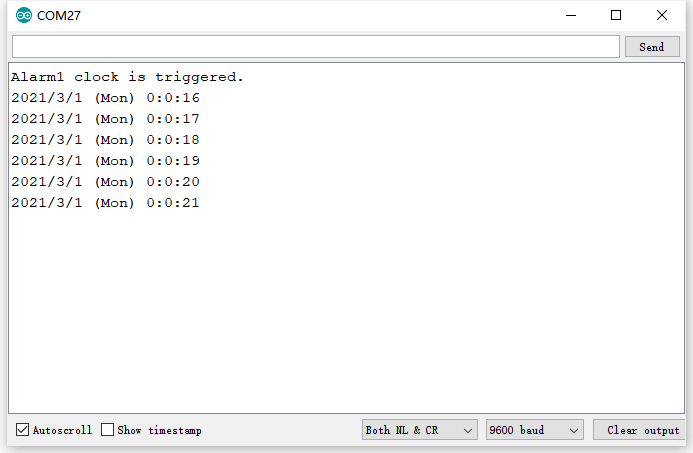
样例代码6 - 时钟输出方波
启用32K引脚和让sqw引脚输出1HZ方波
/*!
* @file setSqwAnd32k.ino
* @brief Set the mode of pin sqw and 32k output
*
* @copyright Copyright (c) 2010 DFRobot Co.Ltd (http://www.dfrobot.com)
* @licence The MIT License (MIT)
* @author [LuoYufeng](yufeng.luo@dfrobot.com)
* @version V0.1
* @date 2021-2-23
* @url https://github.com/DFRobot/DFRobot_DS323X
*/
#include "DFRobot_DS323X.h"
DFRobot_DS323X rtc;
void setup(void)
{
Serial.begin(9600);
/*Wait for the chip to be initialized completely, and then exit*/
while(rtc.begin() != true){
Serial.println("Failed to init chip, please check if the chip connection is fine. ");
delay(1000);
}
/*!
*@brief Set the vaule of pin sqw
*@param mode eSquareWave_OFF = 0x1C // Not output square wave, enter interrupt mode
*@n eSquareWave_1Hz = 0x00 // 1Hz square wave
*@n eSquareWave_1kHz = 0x08 // 1kHz square wave
*@n eSquareWave_4kHz = 0x10 // 4kHz square wave
*@n eSquareWave_8kHz = 0x18 // 8kHz square wave
*/
rtc.writeSqwPinMode(rtc.eSquareWave_1kHz);
/*!
*@brief Read the value of pin sqw
*@return eOFF = 0x1C // Not output square wave, enter interrupt mode
*@n eSquareWave_1Hz = 0x00 // 1Hz square wave
*@n eSquareWave_1kHz = 0x08 // 1kHz square wave
*@n eSquareWave_4kHz = 0x10 // 4kHz square wave
*@n eSquareWave_8kHz = 0x18 // 8kHz square wave
*/
Serial.println(rtc.readSqwPinMode());
/*!
*@brief enable the 32k output
*/
rtc.enable32k();
/*!
*@brief disable the 32k output
*/
//rtc.disable32k();
}
void loop() {
}
常见问题
还没有客户对此产品有任何问题,欢迎通过qq或者论坛联系我们!
更多问题及有趣的应用,可以 访问论坛 进行查阅或发帖。
